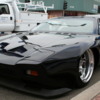Jim,
adjust the rears to make the lower rear control arms parallel to the garage floor. You can measure between the floor & control arm near the pivot & out near the carrier, adjust until the measurements are the same.
Then lower the front end until the door sills are level. If you want to give the car a nose down attitude as Peter mentions, pick some point between the chassis & floor just in front of the front tires & lower the front end another 1/2" beyond level. This is a touchy adjustment, so don't go too far. You are sacrificing positive caster & straight ahead stability in favor of a lower cg and aerodynamics. You are also putting that fiberglass air dam lower to the ground and more likely to scrape on driveways, etc. I believe lowering the nose is more beneficial to the Ford era Panteras that don't have that big air dam like your beautiful GT5 does.
Of course, after you've done all that, you really need to take the car to somebody who has the scales to do a 4 corner weighting.
your amigo


